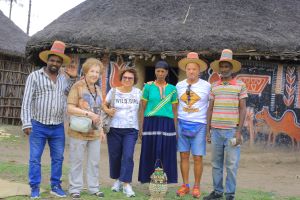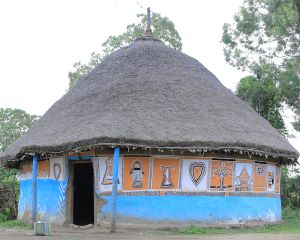Colourfully Painted Huts of Halaba People
In Central Ethiopia Region a farming tribe known as Halaba, residents don’t just wear their hearts on their sleeves, they adorn their homes accordingly. The building items for construction, the structure & type of cultural hut of Halaba is more or less similar with cultural huts of some tribes in Central Ethiopia, colourful paintings inside and outside of the huts are exceptional & no where you can see.

When we take a look at the construction of the huts, the top part is cone shaped and covered with grass. At the centre of the house a thick pole about eight meters height and the hut has two doors or entrances (at the front and back). The entrance door beams are made of hand chiselled wood beams. The door of the hut is about two meters long. The inside part of the hut is divided into two main sections. At one side of the hut, there is a quarter for livestock and the upper part uses for putting various items, called “kota”, loft. The other partition has bedrooms for husband & wife, for kids and small kitchen with equipment.

According to some elders living in Halaba Zone, the construction of the hut’s, tradition began in the 16th C. and for many years most buildings in the Zone had been painted to display what individuals hold from professions and faith to even dreams for the future. Artfully painted walls draw interest from both near & far.
The paintings on the interior and exterior part of the wall are designed and made from natural pigments and they mostly use black, white & red, though other vibrant, less-traditional colours have also found their way into the mix, adorning both interiors & exteriors; but whatever the hues or designs involved, the painted huts of Halaba have both aesthetic and storytelling value elevating this farming Zone into National & international art attraction.

for eg:- the bus a woman painted on her hut, expressing hope to one day she will buy a vehicle in which to drive passengers and supplement to her farming income, or the lion seen on many walls, a symbol of power, one of the prominent symbols in Ethiopian history.
